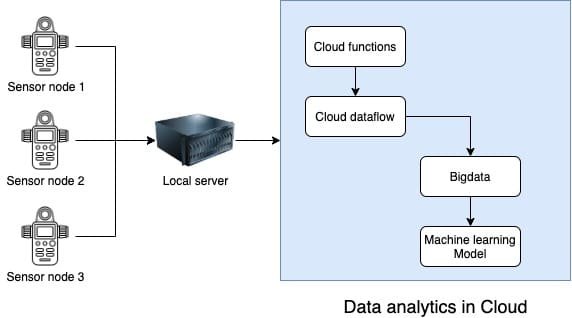People spend most (90%) of the time indoor and indoor air is 3-5 times polluted than outdoor, IAQ poses a major health concern if it was not maintained properly. Imagine an indoor office environment where thousands of professional working under the same roof. The main factors that influence IAQ are temperature, chemicals, soil gas, microbes, humidity, ventilation, and pets.
IoT is an emerging area and it can fit the various domains and applications. The system that contains sensor networks and has the ability to work in real-time would be compatible to solve this problem. There comes the need for an intelligent and Autonomous system that controls and manages the air quality automatically in such an environment. This solution finds application in various fields such as enclosed office buildings, schools and emergency responders who would know which place in the building is safe to go.
System Architecture:
The main component of the system includes a sensor node, base station, and the essential cloud server. The distributed IoT sensors installed in different locations of the indoor premises collect the data periodically, then this data is being stored in the cloud. This data from several connected systems form big data which was further used for real-time analyzing and processing. As shown here (https://www.iotworlds.com/en/what-is-the-role-of-machine-learning-in-iot/) Machine learning could also become a part of enhancing the system with the help of these big-data. Cloud plays the role of heart to the whole system because it is where the data, AI algorithms being centrally managed.

Sensor nodes or an array of sensors are used to collect the air pollution readings which is then being pushed to the cloud for further data processing and analyzing. Data processing here involves the process of extracting useful and timely information from the captured data to support decision making. Using the centrally managed architecture helps in multiple ways such as data could be used for lifetime use and the integration of multi-scenario situations to every system.
Scenarios for Indoor Air Quality (IAQ) maintenance
Although this system finds application in many indoor spaces for air quality monitoring, the uniqueness is that its special application for the following situations needs its design to be tailored.
- Consider a dangerous gas leak in an indoor environment, and the emergency responders would like to know where it is safe to go in that indoor environment.
- Workers with all the focus on their duty, their general sense gets blurred. There would be a situation where the air quality inside that environment has gone down to below average and it will cause a serious threat. Such a kind of situation should be solved autonomously so that the humans in that environment feel safe and comfortable.
- Hazardous locations like subway, tunnels which are difficult to reach, would definitely get an advantage over less maintenance and energy-efficient centralized air quality monitoring system.
- Schools: in order to increase the performance of students, their health plays a main role, which could be possibly be disturbed by the bad air quality.


